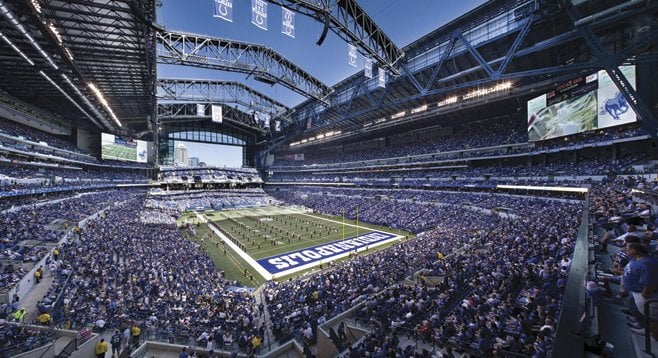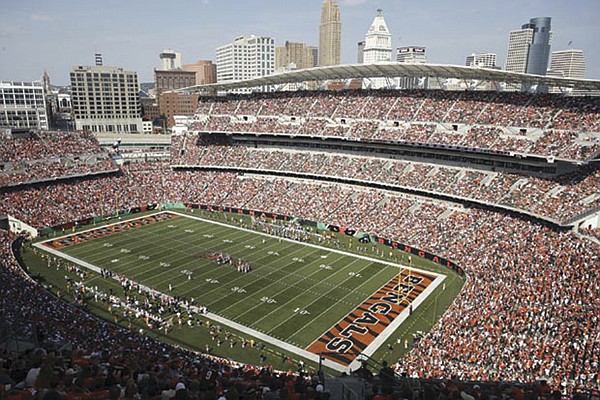 Facebook
Facebook
 X
X
 Instagram
Instagram
 TikTok
TikTok
 Youtube
Youtube

On August 17 of last year, San Diego Chargers flack Mark Fabiani told a KPBS audience that local taxpayers would have to pick up most of the tab for a new stadium so the team could stay competitive. “The average [public] subsidy in the [National Football League] is about 65 percent of the cost of a stadium,” quoth the silver-tongued spokesman. “If we spend 100 percent private funding for a stadium, we’d be in a worse financial position than we are now, vis-à-vis our competitors.”

Wrong again, Mark. A new book by Harvard urban planning professor Judith Grant Long, Public/Private Partnerships for Major League Sports Facilities, shows that for the 121 venues in use during 2010, the public picked up 78 percent of the tab, not 65 percent. This means that if a new Chargers stadium costs $1 billion, which is likely, local taxpayers would plunk in almost $800 million — an outrageous sum.

In total, American taxpayers spent $10 billion more on those 121 facilities than they were told they would shell out by the media and the sports industry. Professor Long figures that hidden costs of land, infrastructure, and lost property taxes add 25 percent to the taxpayer bill. She subtracted money that comes back to cities and states from rent payments and other deal-related revenue.
Writes Long, “Given that popular reports set expectations of more or less equal partnerships between host cities and teams, those estimates of public costs indicate that the public/private partnerships underlying these deals are highly uneven.” In nonacademic prose, she would say that what is presented to the public is malarkey, and the people are likely to get screwed while billionaire team owners rake in the bucks.
She concludes that the public should not pay any part of the building costs. “Land and infrastructure you help with,” she told Bloomberg news. “The building? Let them go it alone.” She says that the realistic cost of sports facilities receives little attention from researchers “because most economic analyses demonstrate that sports facilities produce very few or no net new economic benefits relative to construction costs alone, and, so, in this sense, more accurate cost estimates would only serve to reinforce a case already made.” Objective economists have already shown that sports facilities don’t jack up the economy, as promoters claim.
Warning to San Diego: small metro areas fare worse than larger ones because they have to put up more bucks to keep a team from moving to a juicier market, according to Long.
Sports economists I talk with say Long’s figures are definitely in the…er, uh…ballpark. “You can take Judith Long’s figures to the bank,” says Rodney Fort, professor of sport management at the University of Michigan. “She has done the most extensive and most important work on figuring the totality of subsidies [in pro sports].”
I, for one, have always believed that a big part of the sports scam is that the team counts naming and advertising-signage rights as parts of its contribution, thereby skimping on its own capital. Why doesn’t the city get, or at least split, the income from naming rights? Long does figure that in certain cases, granting naming rights to the team is essentially a public expense, and Fort agrees.
Why is the public misinformed? “The press doesn’t think to ask [about hidden costs],” says Fort. People focus on bonds needed to pay for a project and neglect to ask the right cost questions.
Roger Noll, professor of economics emeritus at Stanford, says infrastructure costs, which could come to 10 to 15 percent of the expense of a project, might be downplayed by the promoters, “although if you ask them [for the numbers], they will tell you.”
Dennis Coates, professor of economics at the University of Maryland, Baltimore County, who blesses Long’s figures, says that forgiveness of property taxes is increasingly a part of subsidized deals. “Some will say that [tax forgiveness] is not really a cost, but of course it is a cost,” he says. He also feels mainstream media are often responsible for the public’s ignorance of a project’s cost. “Local newspapers and TV and radio broadcasters get an enormous amount of revenue” from sports coverage. Reporters realize that.

Long points out in the book that three facilities — Miller Park in Milwaukee, Paul Brown Stadium in Cincinnati, and Lucas Oil Stadium in Indianapolis — actually racked up more in subsidies than they cost to build.

Miller is classic. Bud Selig, owner of the Milwaukee Brewers, promised he would build a ballpark with his own money if local officials would only move a highway at a cost of $6 million. Later, he went to then-governor Tommy Thompson for help. In a slick move, Thompson got the state legislature to hike sales taxes in the counties around Milwaukee. Selig would still have to put in money, but he wiggled out of that, too. Ultimately, he got the stadium for nothing. Awed team owners made him commissioner of Major League Baseball. (Thompson, who was defeated for the Senate last month, was known as the politician who conquered social welfare — but hardly corporate welfare.)
The Wall Street Journal called Cincinnati’s football stadium and ballpark “one of the worst professional sports deals ever struck by a local government.” Costs for the stadium escalated, taxes jumped, and the stadium fund went deeply into the red. According to Cincinnati magazine, the Bengals owner’s “litigious bullying” has prohibited compromises from lifting Hamilton County out of desperate straits caused by the one-sided deal. (The arrangement with the Cincinnati Reds for the baseball park wasn’t quite as financially disastrous.)
When Baltimore wouldn’t give its Colts a new stadium in 1984, they moved in the middle of the night to Indianapolis, which gave them one. Several years later, the Colts wanted another one, or they would move. Indianapolis caved. Hotel, rental car, and restaurant taxes went up. City fathers appeased taxpayers, saying Indianapolis would get a Super Bowl in 2012. It got one — and lost money on it. ■
Contact Don Bauder at 619-546-8529


On August 17 of last year, San Diego Chargers flack Mark Fabiani told a KPBS audience that local taxpayers would have to pick up most of the tab for a new stadium so the team could stay competitive. “The average [public] subsidy in the [National Football League] is about 65 percent of the cost of a stadium,” quoth the silver-tongued spokesman. “If we spend 100 percent private funding for a stadium, we’d be in a worse financial position than we are now, vis-à-vis our competitors.”

Wrong again, Mark. A new book by Harvard urban planning professor Judith Grant Long, Public/Private Partnerships for Major League Sports Facilities, shows that for the 121 venues in use during 2010, the public picked up 78 percent of the tab, not 65 percent. This means that if a new Chargers stadium costs $1 billion, which is likely, local taxpayers would plunk in almost $800 million — an outrageous sum.

In total, American taxpayers spent $10 billion more on those 121 facilities than they were told they would shell out by the media and the sports industry. Professor Long figures that hidden costs of land, infrastructure, and lost property taxes add 25 percent to the taxpayer bill. She subtracted money that comes back to cities and states from rent payments and other deal-related revenue.
Writes Long, “Given that popular reports set expectations of more or less equal partnerships between host cities and teams, those estimates of public costs indicate that the public/private partnerships underlying these deals are highly uneven.” In nonacademic prose, she would say that what is presented to the public is malarkey, and the people are likely to get screwed while billionaire team owners rake in the bucks.
She concludes that the public should not pay any part of the building costs. “Land and infrastructure you help with,” she told Bloomberg news. “The building? Let them go it alone.” She says that the realistic cost of sports facilities receives little attention from researchers “because most economic analyses demonstrate that sports facilities produce very few or no net new economic benefits relative to construction costs alone, and, so, in this sense, more accurate cost estimates would only serve to reinforce a case already made.” Objective economists have already shown that sports facilities don’t jack up the economy, as promoters claim.
Warning to San Diego: small metro areas fare worse than larger ones because they have to put up more bucks to keep a team from moving to a juicier market, according to Long.
Sports economists I talk with say Long’s figures are definitely in the…er, uh…ballpark. “You can take Judith Long’s figures to the bank,” says Rodney Fort, professor of sport management at the University of Michigan. “She has done the most extensive and most important work on figuring the totality of subsidies [in pro sports].”
I, for one, have always believed that a big part of the sports scam is that the team counts naming and advertising-signage rights as parts of its contribution, thereby skimping on its own capital. Why doesn’t the city get, or at least split, the income from naming rights? Long does figure that in certain cases, granting naming rights to the team is essentially a public expense, and Fort agrees.
Why is the public misinformed? “The press doesn’t think to ask [about hidden costs],” says Fort. People focus on bonds needed to pay for a project and neglect to ask the right cost questions.
Roger Noll, professor of economics emeritus at Stanford, says infrastructure costs, which could come to 10 to 15 percent of the expense of a project, might be downplayed by the promoters, “although if you ask them [for the numbers], they will tell you.”
Dennis Coates, professor of economics at the University of Maryland, Baltimore County, who blesses Long’s figures, says that forgiveness of property taxes is increasingly a part of subsidized deals. “Some will say that [tax forgiveness] is not really a cost, but of course it is a cost,” he says. He also feels mainstream media are often responsible for the public’s ignorance of a project’s cost. “Local newspapers and TV and radio broadcasters get an enormous amount of revenue” from sports coverage. Reporters realize that.

Long points out in the book that three facilities — Miller Park in Milwaukee, Paul Brown Stadium in Cincinnati, and Lucas Oil Stadium in Indianapolis — actually racked up more in subsidies than they cost to build.

Miller is classic. Bud Selig, owner of the Milwaukee Brewers, promised he would build a ballpark with his own money if local officials would only move a highway at a cost of $6 million. Later, he went to then-governor Tommy Thompson for help. In a slick move, Thompson got the state legislature to hike sales taxes in the counties around Milwaukee. Selig would still have to put in money, but he wiggled out of that, too. Ultimately, he got the stadium for nothing. Awed team owners made him commissioner of Major League Baseball. (Thompson, who was defeated for the Senate last month, was known as the politician who conquered social welfare — but hardly corporate welfare.)
The Wall Street Journal called Cincinnati’s football stadium and ballpark “one of the worst professional sports deals ever struck by a local government.” Costs for the stadium escalated, taxes jumped, and the stadium fund went deeply into the red. According to Cincinnati magazine, the Bengals owner’s “litigious bullying” has prohibited compromises from lifting Hamilton County out of desperate straits caused by the one-sided deal. (The arrangement with the Cincinnati Reds for the baseball park wasn’t quite as financially disastrous.)
When Baltimore wouldn’t give its Colts a new stadium in 1984, they moved in the middle of the night to Indianapolis, which gave them one. Several years later, the Colts wanted another one, or they would move. Indianapolis caved. Hotel, rental car, and restaurant taxes went up. City fathers appeased taxpayers, saying Indianapolis would get a Super Bowl in 2012. It got one — and lost money on it. ■
Contact Don Bauder at 619-546-8529
Comments